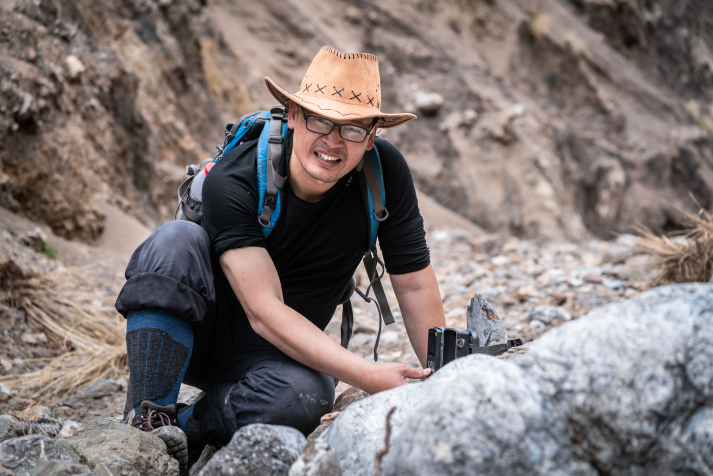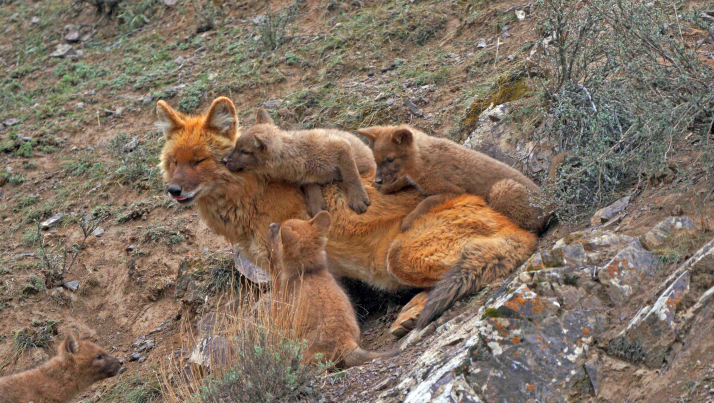| China |
| Exploring the intricacy of wildlife conservation, where every step counts for nature | |
|
|
 Liu Yanlin conducts a snow leopard survey in the Qilian Mountains in June 2019. He installed infrared cameras in areas where snow leopards might roam the grounds (XIONG JIJI)
Liu Yanlin, a teacher in the School of Life Sciences in Qinghai Normal University, has about 20 years of experience in studying wildlife in the Qinghai-Xizang Plateau. His deep connection to the plateau and wildlife can be traced back to his college years. In 1999, he enrolled at Beijing-based Peking University, one of China's most prestigious educational institutions, where he majored in biology. His passion for adventure was ignited when he saw a recruitment notice from the Mountaineering Association of Peking University, seeking members to climb Mount Kezisele, which rises to an impressive 6,525 meters at the westernmost tip of China. Growing up in Beihai, a coastal city in Guangxi Zhuang Autonomous Region in south China, Liu had always been surrounded by relatively flat landscapes, with no opportunity to explore snow-covered high mountains. This longing for adventure and elevation drove him to join the association, and mountain climbing quickly became a big part of his college experience. Through these climbs, Liu not only fulfilled his desire for high-altitude exploration but also developed the adaptability needed to thrive in the rugged wilderness of plateaus. Learning the ropes In 2011, Liu earned his Ph.D. and took a position at the Shan Shui Conservation Center (SSCC), a non-governmental organization founded by his mentor, Professor Lu Zhi, a renowned conservation biologist specializing in studying large carnivores such as snow leopards and brown bears, along with their habitats. The day before Liu departed for Yushu in Qinghai Province for a project after he joined the SSCC, he married his girlfriend, whom he had met while mountain climbing. His wife has been a steadfast source of support, fully understanding the demands of his conservation work. After five years at the SSCC, Liu briefly left the Qinghai-Xizang Plateau in 2016 to join a scientific expedition to Antarctica. Following this adventure, he spent three years at the Chinese Academy of Forestry, where he pursued his postdoctoral degree and contributed to assessing wildlife conservation status in the Sanjiangyuan region, known as the Three River Source, where the Yangtze, Yellow and Lancang rivers originate. In July 2019, Liu became a member of the Chinese Felid Conservation Alliance, focusing on the investigation and protection of Chinese mountain cats, snow leopards, and other feline species in the Qilian Mountains. He also participated in initiatives aimed at safeguarding the North China leopard. In 2023, Liu transitioned to a teaching role at Qinghai Normal University, where he continues his research while also inspiring and training the next generation of animal conservationists. Human/wildlife clashes To the average person, Liu's journey over the past 20 years may seem extraordinary and romantic, especially when they see the stunning wildlife photographs he captures alongside his selfies during scientific expeditions. His job often evokes envy. However, the reality of working in the field for animal research and conservation is far more demanding and tedious. Each year, Liu spends six to nine months in remote, high-altitude areas, enduring harsh conditions. His daily routine involves tracking wild animals, setting up and retrieving infrared cameras, and conducting surveys in nearby villages. There are times when he may not encounter another person for 10 days, or even half a month, and the animals he is studying might be elusive as well. Throughout this challenging work, he must also navigate unexpected hazards, underscoring the difficulties faced by those dedicated to wildlife conservation. What impressed Liu the most were the early days after he joined the SSCC in 2011, when he studied brown bears in the Sanjiangyuan region. In June of that year, his team fitted two wild brown bears—a male and a female—with tracking collars. On July 3, as usual, Liu and his colleagues followed the footprints of the bears using satellite positioning and radio signals from the collars. As they approached the mountaintop, they suddenly heard a powerful roar. The female bear, named Drolma, burst out from behind the ridge about 30 meters away, growling fiercely with two cubs trailing behind her. When she was just 15 meters from Liu and his team, Drolma paused and turned back toward the ridge, repeating this behavior three times, clearly warning them to stay away. This encounter was Liu's first experience being fewer than 20 meters away from an adult brown bear, and it sent a shiver down his spine. Instinctively, he leaned against his two teammates for support, raising their arms high to appear larger, and they slowly backed away. Eventually, Drolma retreated behind the mountain ridge, leading her cubs with her. This incident prompted Liu to reflect on the relationship between humans and wild animals once he had recovered from the intense situation. He realized that the encounter with the bears was not entirely coincidental. Drolma was one of the two brown bears being closely monitored by Liu's research team. Within less than a year, she had roamed an area exceeding 4,000 square km with her cubs, often traversing human-dominated landscapes during the night. As herders expanded into the deep wilderness, their habitats inevitably overlapped with those of the brown bears. The enticing food left in homes attracted these massive creatures, which can weigh over 100 kg and run at speeds of up to 60 km per hour. This made the bears a threat to local residents, given their powerful forelimbs and sharp teeth. Liu considers large carnivores like brown bears symbols of the wilderness in west China, but for local herders, they represent conflict, risk and loss. Brown bears, wolves and snow leopards may destroy their houses, and eat their food and livestock.  A pack of jackals in the wild, with young ones playing around the male leader of the pack (LI YIBIN)
Rethinking approaches Escalating conflicts between humans and wildlife are not confined to the remote plateaus; they are a pressing issue in global wildlife conservation efforts. Traditionally, nature reserves have been established as off-limits zones for human activity, creating a rigid approach to wildlife protection. However, Liu has been advocating for a more flexible model for years, seeking innovative solutions to foster coexistence. On the Qinghai-Xizang Plateau, a collaborative effort is underway, involving herders, local governments and conservationists like Liu. They are experimenting with various strategies, including digging holes in pastures, installing solar-powered electric fences and offering compensation for damages caused by wildlife. Additionally, the use of infrared cameras, satellite tracking collars and DNA analysis from animal droppings has become instrumental in monitoring animal populations and understanding the intricate dynamics between humans and wildlife. For the past 20 years, Liu has immersed himself in the rugged terrain of the plateau. No longer just an adventurer drawn to the allure of snow-capped peaks, he has dedicated his life to studying the relationships between wild yaks, brown bears and snow leopards, and their interactions with local communities. Each year, he traverses mountains and rivers, tracing the footprints of these magnificent creatures, which fuels his unwavering commitment to ecological preservation. Through his work, Liu is not only shedding light on the pressing challenges of human-wildlife conflicts but also inspiring a rethinking of how we approach conservation in a rapidly changing world. His passion and perseverance highlight the need for collaboration and innovation in the quest to protect our planet's precious biodiversity. BR (Print Edition Title: Roars and Research) Copyedited by Elsbeth van Paridon Comments to weiyao@cicgamericas.com |
|
||||||||||||||||||||||||||||
|